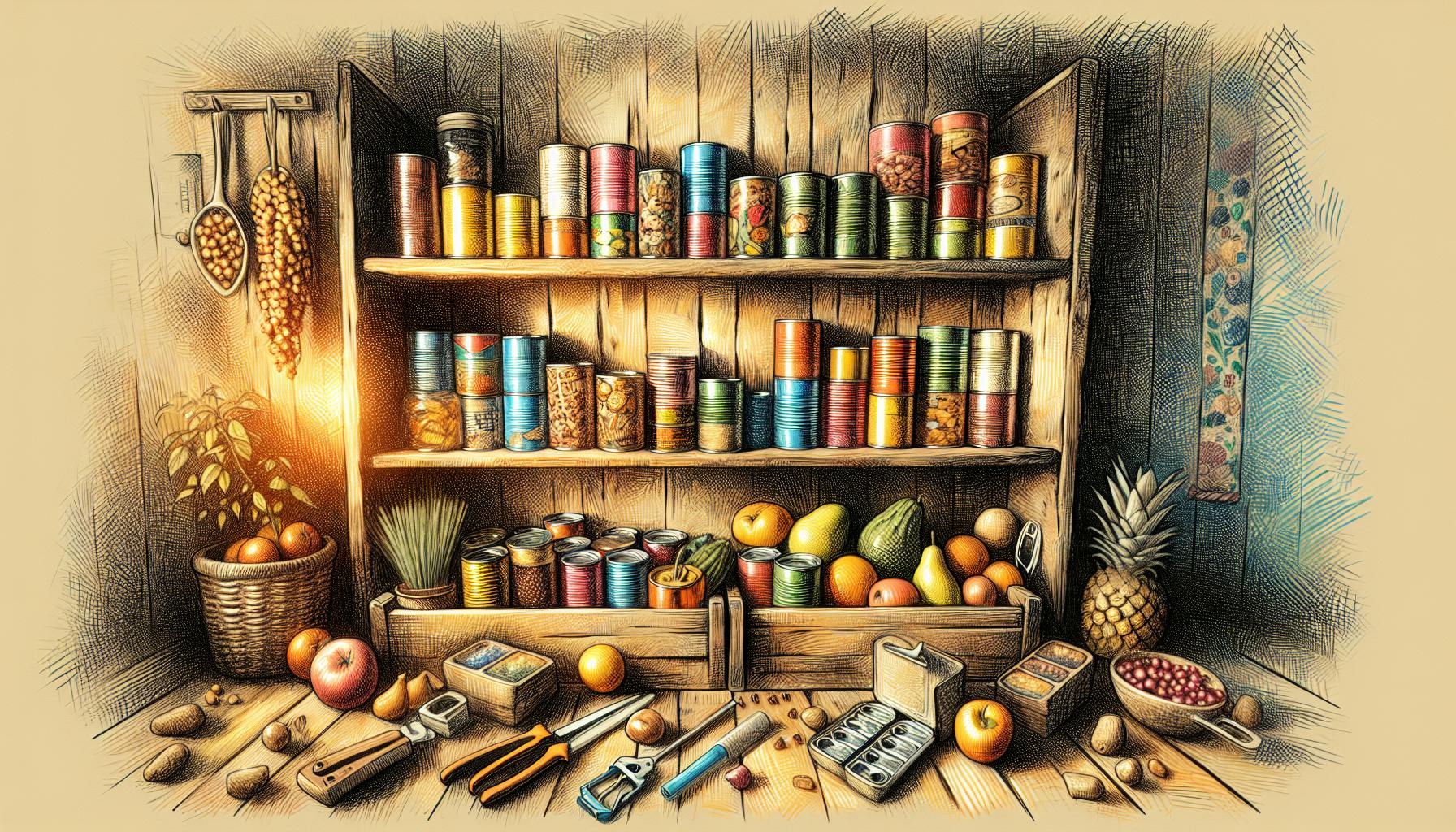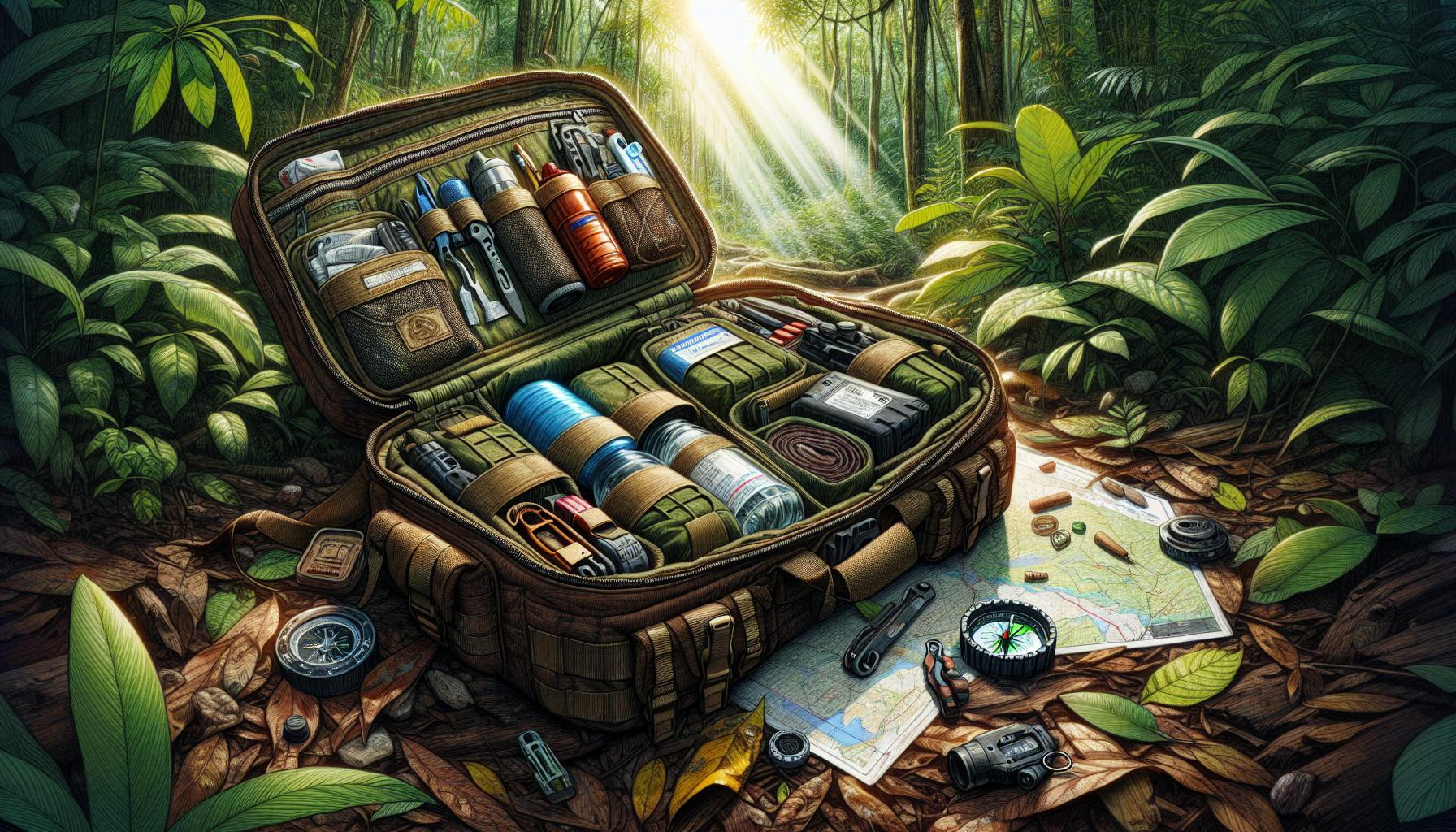Building a comprehensive stockpile of shelf-stable foods is one of the most important preparedness steps for preppers. Having a supply of survival food items that provide balanced nutrition, long shelf life, and versatility is crucial in an emergency when stores may be inaccessible. This definitive guide covers the essential categories of foods to include in your prepper’s pantry, recommended quantities to stockpile, storage considerations to maximize freshness, and creative recipes to make satisfying meals from your stockpiled ingredients. Follow these recommendations and you’ll have the well-rounded list of survival food items to feed your family in a crisis.
Introduction
When building your prepper food supply, the key is stockpiling non-perishable nutrition that will last for years on the shelf without losing quality or going bad. Canned goods, dehydrated produce, dried beans and lentils, grains like rice and quinoa, shelf-stable fats like oils and nuts are all important components. Focus on foods that require minimal cooking and preparation in case fuel sources are limited in an emergency. Consider nutritional value, shelf life, and versatility when selecting items for your stockpile. This guide covers the essential categories to include and recommended quantities to meet daily caloric needs.
Recommended Quantities
As a general rule of thumb, the average sedentary adult requires around 2,000 calories per day to maintain weight. However, food requirements can vary greatly based on age, size, activity level and health status. Here are some recommendations for stockpiling quantities:
- Grains/cereals/pastas - 300-500 grams per person per day
- Canned proteins - 200-300 grams per person per day
- Fats and oils - 125 grams per person per day
- Dried veggies - 150 grams per person per day
- Dried fruits - 100 grams per person per day
- Canned fruits/veggies - 400 grams per person per day
- Comfort foods - 50 grams per person per day
When in doubt, stock more than you think you'll need, as food supplies also serve as barter currency in a collapse scenario.
Canned and Jarred Foods
Canned goods are a prepper staple because they keep for 2-5 years and provide essential vitamins and minerals. Stock up on:
-
Canned proteins like tuna, salmon, sardines and chicken packed in water for affordable sources of protein and healthy fats. Aim for 5-8 cans per person monthly.
-
Canned fruits and vegetables like tomatoes, carrots, green beans, peaches and pears packed in juice provide key micronutrients and prevent scurvy. Get a variety - at least 8-10 cans per person monthly.
-
Low-sodium options when possible to avoid excess sodium intake. Look for “no salt added” labels.
-
BPA-free cans to prevent potential health hazards from chemical linings. Eden Foods and Amy's Kitchen offer BPA-free cans.
Dried and Dehydrated Foods
Removing the moisture extends shelf life, making dried foods perfect for stockpiling.
-
Beans and lentils provide plant-based protein and high fiber. They keep for years when properly stored - aim for 2-4 lbs per person.
-
Dehydrated fruits like apple slices, mangos, bananas add back sweetness and nutrients.
-
Jerky made from beef, turkey, or salmon gives you a tasty condensed protein source.
-
Freeze-dried meals from Mountain House or Auguson Farms require minimal prep - just add hot water. Lightweight and compact.
-
Trail mixes with raisins, peanuts, sunflower seeds, chocolate provide energy-dense calories.
Grains, Cereals, Pasta
Rice, quinoa, oats, pasta offer budget-friendly sources of carbohydrates for energy and fiber.
-
Opt for whole grains like brown rice and steel-cut oats when possible for more nutrition.
-
Stock up on fortified cereals and instant oatmeal packets for an easy breakfast.
-
Choose pastas made from chickpea, quinoa or brown rice for extra protein and nutrients.
-
Store in airtight containers with oxygen absorbers to prolong shelf life.
Fats and Oils
Don’t forget healthy fats, which provide flavor, calories, and help satisfy hunger:
-
Oils like olive oil, coconut oil, and avocado oil for cooking, dressings, and general use. Go for small bottles and limit air exposure through proper storage.
-
Nuts, nut butters, seeds, trail mix supply fats along with plant protein.
-
Powdered oils take up less storage space. Add water to reconstitute into oil.
-
Ghee clarified butter keeps far longer than raw butter.
-
Coconut butter is another tasty, shelf-stable fat option.
Beverages and Condiments
Flavor and variety are important for morale. Stock up on:
-
Instant coffee, tea bags, powdered milk for warm comforting drinks.
-
Honey, molasses, maple syrup to naturally sweeten foods.
-
Soy sauce, vinegar, hot sauce, bouillon cubes add welcomed flavor.
-
Canned coconut milk for making curries, chilis and Asian dishes.
Vitamins and Supplements
Round out your stockpile with key vitamin supplements:
-
Multivitamins provide nutritional insurance for any gaps in your storage.
-
Vitamin C, Vitamin D, calcium, and iron supplements.
-
Electrolyte powders to create rehydration drinks.
-
Seaweed supplements support thyroid function.
-
Glucosamine for joint health.
Essential Nutrients in Survival Foods
When building your stockpile, ensure you have a nutritionally balanced food supply by prepping items rich in essential vitamins, minerals and macronutrients.
-
Pack carbohydrates for energy - grains, pasta, dried fruits and veggies.
-
Include proteins for muscle repair - beans, canned fish, jerky, peanut butter.
-
Healthy fats provide satisfied hunger - oils, nuts, seeds, coconut.
-
Focus on nutrient-dense foods to get needed vitamins and minerals.
-
Choose items with fiber like oats, beans, vegetables, bran cereals.
-
Variety ensures you cover all your nutritional bases.
Vitamin C
Vitamin C supports immune function and collagen production. Stock up on:
-
Powdered vitamin C supplements - look for mixes containing acerola cherry or camu camu berry powder which are naturally rich sources.
-
Canned tomatoes, mandarin oranges, pineapple packed in juice rather than syrup.
-
Dehydrated rose hips, acerola cherries, sea buckthorn.
-
Citrus juice concentrates - lemon, lime, grapefruit can last 6 months refrigerated once opened.
Protein
Protein is essential for building and repairing muscles and tissues. Good shelf-stable sources include:
-
Canned salmon, sardines, chicken, turkey packed in water has long shelf life. Stock at least 10 cans per person monthly.
-
Canned or dried beans, chickpeas, and lentils offer plant-based protein.
-
Peanut butter, almond butter, sunflower seeds, cashews.
-
Whey protein powder stores for years and can be added to foods.
-
Beef jerky or pemmican as tasty concentrated protein sources.
Calcium
Required for bone health and nerve signaling - stock up on:
-
Sardines and salmon with bones provide highly bioavailable calcium.
-
Powdered milk, evaporated milk, and milk substitutes like soy or almond milk.
-
Tofu, beans, leafy greens like kale, broccoli, calcium-fortified juices.
-
Consider a shelf-stable calcium supplement like caltrate.
Iron
Vital for blood health. Get more from:
-
Dried fruits like prunes, raisins, apricots - rich sources of iron.
-
Iron-rich blackstrap molasses - can be used as a sweetener.
-
Canned sardines, clams, pumpkin seeds, lentils.
-
Fortified instant oats, cereals and grain bars.
-
Pair iron foods with citrus fruits or juices to increase absorption.
Fiber
Promotes digestion and gut health. Find in:
-
Beans, lentils, split peas, chickpeas - high in both fiber and plant protein.
-
Oats, chia seeds, flax seeds, nuts and nut butters.
-
Some canned vegetables like carrots, beets, tomatoes contain fiber.
-
Opt for whole grain pasta, cereal, bread products when possible.
-
Consider a psyllium husk supplement.
Key Considerations for Maximizing Shelf Life
Proper storage is crucial to extend the shelf life of your stockpiled food. Follow these guidelines to keep food fresh for years to come.
-
Store in cool, dry place around 50°-60°F to prevent spoilage. Avoid temperature fluctuations.
-
Use oxygen absorbers and moisture absorbers to create ideal storage conditions.
-
Follow “first in, first out” system when rotating stock. Use foods before their expiration dates.
-
Look at best-by dates as guidelines for peak quality, not safety. Inspect cans and packaging.
Cool, Dry Storage
The ideal conditions for maximizing shelf life are:
-
Stable temperatures between 50°-60°F - avoids temperature extremes.
-
Low humidity around 60% - use desiccant packs if needed to control moisture.
-
Oxygen absorbers remove oxygen that speeds food spoilage.
-
Consider underground root cellars which provide stable temperature and humidity naturally.
Mylar Bags and Oxygen Absorbers
Mylar bags create an air-tight, oxygen-free environment.
-
Foil pouches prevent oxygen exposure which causes food spoilage.
-
Oxygen absorbers remove oxygen before sealing bag or bucket.
-
Allows long term storage of grains, beans, nuts - decades if properly sealed.
-
Come in various sizes from sandwich bags to 5 gallon drum liners.
Canned Goods Storage
To maximize canned food shelf life:
-
Store cans at 50°-70°F - avoids temperature extremes that can damage cans.
-
Keep cans in a dark, dry place - sunlight can degrade cans over time.
-
Limit stacking to two cans high to prevent denting.
-
Use "first in, first out" system and check expiration or best-by dates.
Freezing and Refrigeration
Cold temperatures slow food spoilage:
-
Refrigeration preserves foods for short term under proper conditions - just a few weeks for most items.
-
Freezing stops microbial growth and keeps food safe long term if undisturbed - use for meats, cheeses, butter.
-
Blanch vegetables before freezing to deactivate enzymes causing spoilage.
Using Preservatives
Preservatives inhibit microbial growth:
-
Salts, acids, alcohol, and sugars all preserve foods.
-
Honey, molasses, and syrups contain natural antibacterial agents.
-
Dehydrating and freeze-drying food removes moisture needed for bacterial growth.
-
Canning uses heat to kill microorganisms and seal out contaminants.
Choosing Appropriate Storage Containers
Invest in proper food grade storage containers to safely store your survival food stockpile:
-
Plastic buckets with gasket seals are ideal for bulk dry good storage.
-
Mylar bags provide an oxygen-free environment and come in various sizes.
-
Mason jars allow for vacuum sealing and are reusable.
-
Oxygen absorbers remove oxygen from containers to extend shelf life.
-
Ensure containers protect against light, air, moisture, pests.
Plastic Buckets
5-7 gallon buckets with gasket lids are great for bulk dry goods storage:
-
Stackable and waterproof. Can add mylar liners for added protection.
-
Store grains, beans, pasta, rice, dehydrated foods.
-
Properly sealed, a bucket can hold 20-30 lbs of dry goods.
Mylar Bags
Foil pouches prevent air and moisture damage:
-
Create an airtight seal after adding oxygen absorbers.
-
Come in sizes from sandwich bags to large 55 gallon drum liners.
-
Allow easy labeling of contents and date.
Mason Jars
Glass jars allow for vacuum sealing:
-
Come in small and large sizes from 4 oz to 1 gallon.
-
Can store nuts, beans, powders, granola, dried fruits.
-
Durable, reusable, let you visually inspect contents.
Oxygen Absorbers
Small packets absorb oxygen from containers:
-
Toss one in mylar bags, buckets or jars before sealing.
-
Absorbs oxygen that causes food spoilage.
-
Use when storing grains, beans, flours, nuts.
-
Types optimized for different moisture levels.
Plastic Containers
Look for BPA-free airtight plastic containers:
-
Come in handy sizes for everyday pantry use.
-
Clear to easily identify contents.
-
Ensure any plastic meets food-grade standards.
Essential Survival Food Categories
A well-rounded survival food supply contains a variety of nutrients and covers different preparation methods in case utilities are disrupted.
-
Stock canned proteins, fruits and vegetables for balanced nutrition.
-
Include beans, rice, oats as budget-friendly calorie and carbohydrate sources.
-
Don’t forget comfort foods like chocolate, candy, sweets for morale.
-
Diversify across cooking methods - items requiring only hot water or no cooking.
Proteins and Meats
Ensure you have a lasting protein source:
-
Canned salmon, tuna, chicken packed in water provides affordable protein. Stock at least 10 cans per person monthly.
-
Beef jerky or pemmican are tasty concentrated protein options.
-
Beans and lentils offer plant-based protein, fiber, vitamins and minerals.
-
Freeze-dried chicken or hamburger mix from Mountain House and other brands offer lightweight protein.
-
Don't forget plant-based proteins like soy chunks, TVP (textured vegetable protein) and seitan.
Fruits and Vegetables
These provide essential vitamins, minerals and fiber:
-
Canned tomatoes, pumpkin, carrots, potatoes - at least 10 cans per person monthly.
-
Dried apple slices, cranberries, banana chips, pineapple.
-
Canned peaches, pears, mandarin oranges packed in juice.
-
Dehydrated mixed vegetables like those from Harmony House Foods.
-
Powdered vegetable supplements like carrot, potato, onion, spinach, kale.
Grains and Starches
Staples like rice, quinoa, oats, pasta provide carbohydrate fuel:
-
Look for whole grain varieties when possible - brown rice, whole wheat pasta.
-
Stock flour, cornmeal for baking needs - pizza dough, tortillas, bread.
-
Crackers, cereal bars, trail mixes offer grab-and-go options.
-
Don't forget potatoes - store well and provide potassium and vitamin C.
Oils and Fats
These provide calories and essential fatty acids:
-
Olive oil, coconut oil, vegetable oil for cooking and dressings.
-
Nuts, seeds, nut butters, trail mixes.
-
Powdered eggs and egg white powder.
-
Ghee clarified butter, canned butter.
Beverages
Flavor and variety are important for morale:
-
Coffee, tea, powdered milk, shelf-stable non-dairy milk.
-
Honey, molasses, maple syrup, salt, seasonings.
-
Broths, coconut milk, vinegar, hot sauce.
-
Powdered juice mixes, drink powders, electrolyte mixes.
Comfort Foods
Don't forget morale-boosting treats:
-
Chocolate, candy bars, gum
-
Jelly beans, sour candy, hard candy
-
Popcorn, snack chips, pretzels
-
Cookies, cookie dough mixes
-
Canned frosting, sprinkles, baking chips
Equipment and Alternate Preparation Methods
Have backups in case normal cooking isn't possible:
-
A camp stove or rocket stove allows you to cook without power.
-
A solar oven harnesses the sun's energy for cooking.
-
A woodstove, firepit or grill can cook and provide heat.
-
Heavy duty aluminum foil can cook in hot coals or over a campfire.
-
A food dehydrator prepares dried foods for storage.
-
A grain mill allows you to grind wheat and other grains into flour.
Don't forget alternate water sources for reconstituting foods:
-
Store bottled water or fill cleaned soda bottles with tap water.
-
A water filter like the Sawyer Mini removes bacteria from found water sources.
-
Water purification tablets like Potable Aqua disinfect water.
-
A rainwater collection system provides water in wet seasons.
Creative Recipes and Meal Ideas
Get creative with your stockpiled ingredients to make satisfying meals. Here are some ideas:
One-Pot Meals
-
Chili with canned beans, tomatoes, rice or pasta.
-
Curries with coconut milk, veggies, chickpeas.
-
Jambalaya or biryani combining rice, canned chicken, veggies.
-
Hearty soups and stews with canned or dehydrated ingredients.
No-Cook Meals
-
Sandwiches with canned meats, shelf-stable bread, cheese.
-
Trail mix for an easy high-calorie snack.
-
Instant oatmeal or cereal with dried fruits and nuts.
-
Canned fish served with crackers.
-
Peanut butter on celery or dried fruit.
Baked Goods
-
Breads, rolls, muffins with flour, dried milk, oil.
-
Granola and energy bars with oats, honey, dried fruits.
-
Pancakes or tortillas with dried milk and eggs.


